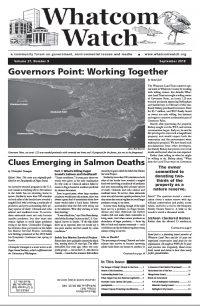by Lorraine Loomis
Federal legislation allowing lethal removal of more sea lions in the lower Columbia River is a good step toward reining in out-of-control populations that are hurting salmon and orca recovery efforts throughout the region.
Treaty tribes in western Washington support U.S. Rep. Jaime Herrera Beutler’s and U.S. Sen. Maria Cantwell’s bipartisan legislation to allow the annual lethal removal of about 900 of the animals on the lower Columbia River where dams slow migrating salmon and create an all-you-can-eat buffet for sea lions. The bill has passed the U.S. House of Representatives, and a companion bill is being considered by the U.S. Senate.
Sea lion populations on the West Coast have more than tripled to about 275,000 since the Marine Mammal Protection Act was created in 1972. Regional salmon managers are concerned about impacts from sea lions and harbor seals on threatened Chinook salmon, especially young salmon just leaving their native streams. Adult Chinook are the favorite food of southern resident killer whales, the endangered orcas that are the focus of a recovery task force in Washington state.
Hershel the sea lion – who showed up for years in the 1980s to feast on steelhead at the Ballard Locks in Seattle – showed us that efforts to scare away sea lions or to trap and relocate the worst offenders don’t work.
Although Washington and Oregon are now allowed to lethally remove about 100 sea lions annually from the lower Columbia River, fewer than 200 have been removed since 2008, according to the Oregon Department of Fish and Wildlife. Increasing that number would not harm the current population.
One regional solution being considered is to boost hatchery production of Puget Sound Chinook to bolster their numbers and provide more food for orcas. But that effort will be for nothing if we don’t also slow the growing populations of seals and sea lions.
In the Puget Sound region, the explosion of harbor seals is driving the decline of both Chinook salmon and resident orcas, according to farmers in Whatcom and Skagit counties. They cite a 2017 report by NOAA Fisheries and other agencies that shows the area’s harbor seal population has grown from about 8,500 to more than 77,000 in the past 40 years.
We agree with their recommendation that the sea lion control effort on the Columbia River be expanded to include harbor seals in Puget Sound.
The Marine Mammal Protection Act was created with the best of intentions to protect seals and sea lions. Back then they needed the help. Now, more than 40 years later, it’s a different story. Those good intentions and lack of management have created an imbalance that must be corrected.
The ongoing loss of salmon habitat in western Washington has led to Indian and non-Indian salmon fisheries being cut 80-90 percent in the past 30 years as managers work to reach spawning escapement goals. The trend for marine mammals is just the opposite. Today they take more salmon in Puget Sound every year than Indian and non-Indian fisheries combined.
Reducing sea lion and seal populations in our region is a difficult, but necessary action that must be taken. Unless we control their numbers, seals and sea lions will continue to eat more salmon every year than any killer whales – or us – could ever hope for.
_________________________________
Lorraine Loomis is chair of the Northwest Indian Fisheries Com-mission, www.nwifc.org.





























